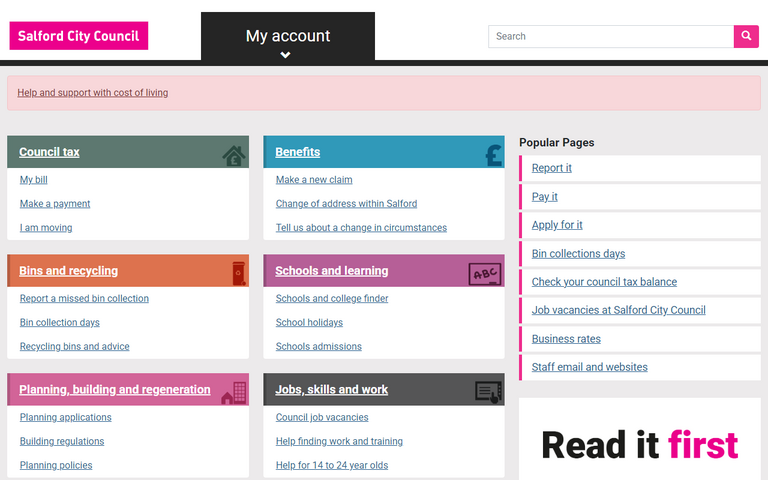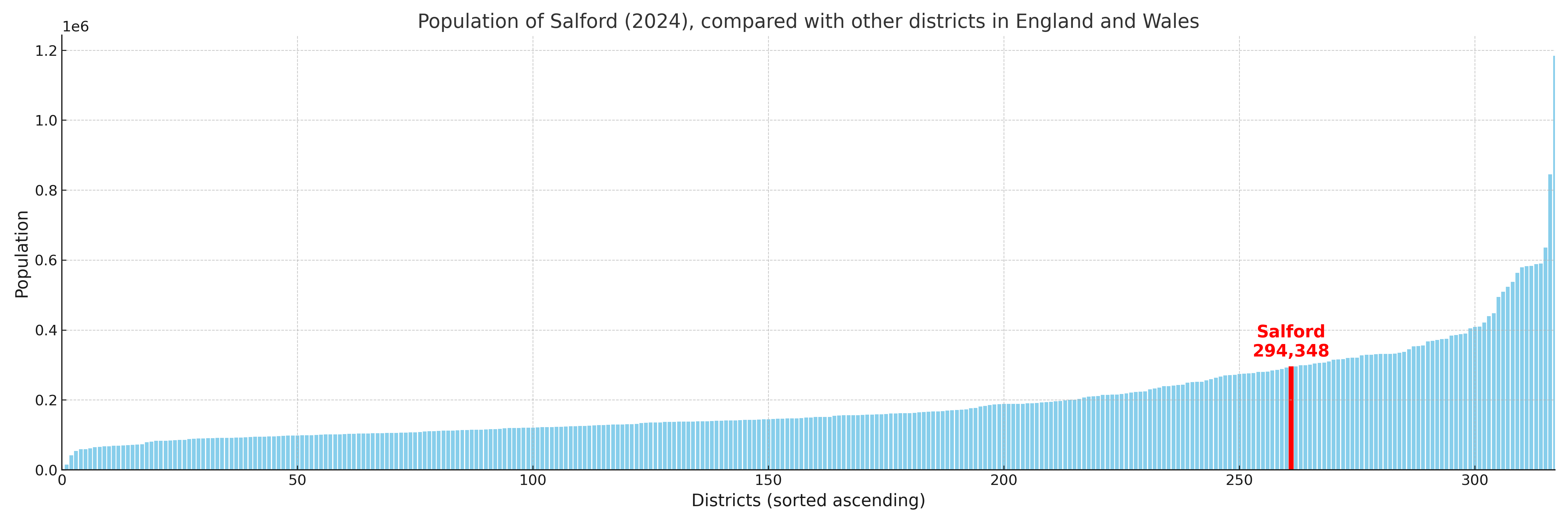Salford
§ This page gives an overview of the Salford local authority district, bringing together key facts, maps, and data to help you quickly understand the area. One of 361 district profiles on Baseview.
Overview ⁞ Salford lies west of Manchester, with a landscape shaped by the River Irwell and the Manchester Ship Canal. Salford Quays is a major landmark, home to The Lowry arts complex, Imperial War Museum North, and MediaCityUK. The wider district includes parks such as Buile Hill Park, Worsley’s historic village with its canal network, and Chat Moss, an expanse of lowland peat bog rich in wildlife. From riverside developments to greenbelt countryside, Salford blends historic waterways with modern culture and industry.
Salford Boundary Map
This map shows the official boundary of the Salford local authority district, based on the latest geographic data published by the Office for National Statistics (ONS). It provides a clear view of the district’s extent and helps you understand how the area fits within the wider regional and national landscape.
Contains OS data © Crown copyright and database right 2025. Source: Office for National Statistics licensed under the Open Government Licence v3.0.
The administrative boundary of Salford can also be viewed on OpenStreetMap: District Boundary of Salford.
Key Facts about Salford
What region is Salford in? Salford is in the North West of England, a region within the UK.
What county is Salford in? Salford is located in the county of Greater Manchester.
Is Salford a city? Yes, Salford is a city. Salford holds official city status as one of the 76 designated cities in the UK.
Who governs Salford? The local government for this district is: Salford City Council (Metropolitan District).
▶ Official website of Salford City Council 🔗 salford.gov.uk

Which police force covers Salford? Policing in Salford is provided by Greater Manchester Police 🔗 gmp.police.uk, which serves 10 local authority districts: Bolton ⁞ Bury ⁞ Manchester ⁞ Oldham ⁞ Rochdale ⁞ Salford ⁞ Stockport ⁞ Tameside ⁞ Trafford ⁞ Wigan.
Constituencies in Salford
Salford is divided into 4 parliamentary constituencies, listed below in alphabetical order.
A constituency is a specific geographical area that elects one Member of Parliament (MP) to represent them in the House of Commons. The United Kingdom is divided into 650 parliamentary constituencies. We have this list page for easy browsing of all UK parliamentary constituencies: List of Constituencies.
Wards in Salford
Salford is divided into 20 wards, listed below in alphabetical order.
- Barton & Winton
- Blackfriars & Trinity
- Boothstown & Ellenbrook
- Broughton
- Cadishead & Lower Irlam
- Claremont
- Eccles
- Higher Irlam & Peel Green
- Kersal & Broughton Park
- Little Hulton
- Ordsall
- Pendlebury & Clifton
- Pendleton & Charlestown
- Quays
- Swinton & Wardley
- Swinton Park
- Walkden North
- Walkden South
- Weaste & Seedley
- Worsley & Westwood Park
In the UK, a ward is a subdivision of a local authority area, used mainly for electoral and statistical purposes. Defined by the ONS, wards represent the primary unit for local elections, each returning one or more councillors to the local council. Wards are also used as a key geography for presenting population and census data.
Parishes in Salford
Salford is entirely unparished—there are no civil parishes in this local authority district.
Parishes are the lowest tier of local government; where they don’t exist, those very local services and representation sit directly with the principal council.
Built-up Areas in Salford
Salford covers 14 built-up areas, listed below in alphabetical order.
- Clifton (Salford) *
- Eccles (Salford) *
- Farnworth *
- Irlam *
- Little Hulton *
- Manchester *
- Old Trafford *
- Pendlebury
- Prestwich *
- Salford *
- Swinton (Salford)
- Walkden *
- Wardley
- Worsley *
In the UK, a Built-up Area (BUA) is a continuous urban area of at least 20 hectares (0.2 km²), defined by the ONS as land where buildings are generally no more than 200 metres apart, such as towns, cities, or large villages. (Note: A BUA name marked with an asterisk (*) indicates that the area is situated partly in the district of Salford.)
Salford compared with other districts in the UK
This section shows how Salford compares with other local authority districts in the UK, using a variety of measures and rankings.
Salford has 20 electoral wards.

Salford has a population of 294,348 (2024 mid-year estimate by ONS)

More local statistics and data for Salford can be found on the ONS statistics for Salford.